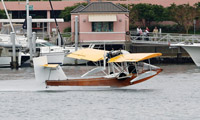Commerical Aviation turns 100
Celebrating commercial flight's centenary
On January 1 this year, aviation reached the magnificent milestone of 100 years of commercial flying. Led by the International Air Transport Association (IATA), global aviation is heralding this landmark achievement with a year of celebrations, which included the enactment of the first flight on January 1.
February 1st 2014
To the world at large, the Wright Brothers are the fathers all of aviation. In fact, little known Tony Jannus is also special. He entered the history books as the pilot of the first scheduled commercial flight a 100 years ago. Read More »
 |
| Aviation’s first commercial flight: across the U.S.’s Tampa Bay |
Piloting a Thomas Benoist-designed “airboat”, chief pilot Jannus flew his solo – and paying – passenger, Abram C. Pheil, across the bay from Florida’s St Petersburg to Tampa. Pheil, a former mayor of St Petersburg, had paid US$400 (calculated to be US$9,200 in 2014) at an auction for the prestige of being the airline’s first passenger on the one way 23-minute seaplane journey.
In a city with a permanent population of 7,000 residents, more than 3,000 people surrounded the pier to witness Jannus and Pheil take off on January 1, one hundred years ago. Jannus skimmed 15 metres above the bay, briefly landed mid journey to adjust a propeller drive chain and landed to the cheers of another 3,000 plus spectators on the Hillsborough River in Tampa. The return journey broke a record, when Jannus flew Benoist Airboat Model XIV no. 43 from Tampa to St Petersburg in 20 minutes.
Jannus began flying two flights a day, charging US$5 each way for passengers and the same amount for 100 lbs (45.5 kgs) of freight. But the fares and air freight income did not cover the costs of operations. The airline reduced its schedule and took flights on request, but still did not make ends meet. The last flight of the St Petersburg-Tampa Airboat Line was on May 5, despite subsidies from the business community and strong community support.
Founded by an electrical engineer, Percival E. Fansler, from Jacksonville, the airline owner had sought out Benoist, who designed airboats, and secured the 43rd airboat of the Benoist Aeroplane Company production line. A forerunner of the seaplane, aircraft no. 43, which could carry one passenger, was joined by no. 45, which could carry two people plus the pilot. This was the airline’s fleet – with the advantage it could take off and land on water in a region where there was plenty of water and not many airports.
When the airline closed, the aircraft no. 43 was rebuilt twice after two crashes and is now lost to history.
Jannus was killed in accident over the Black Sea during World War 1 where he was training Russian pilots for the Curtiss Aeroplane Company. In 1964, the St Petersburg and Tampa Chambers of Commerce established the Tony Jannus Distinguished Aviation Society to honor Jannus and the first airline.
Said Tony Tyler, the director general and CEO of IATA: “In the last century, commercial aviation has transformed the world in ways there were unimaginable in 1914.
“The first flight provided a short cut across Tampa Bay. Today, the aviation industry reunites loved ones, connects cultures, expands minds, opens markets and fosters development.
“We should be guided by the long-term interests of all whose lives that are positively transformed by commercial aviation every day. A hundred years is something worth celebrating. We look forward to creating an equally remarkable legacy for commercial aviation’s second centenary.”
Commemorative activities were launched with the enactment of the first flight on the first day of the year, using a replica of the Benoist airboat. A website, www.flying100years.com, filled with historical and economic reference information, has been designed as an interactive platform that outlines commercial aviation’s value from individual and broader economic perspectives.
Today, on an average day more than eight million people fly. Last year, 3.1 billion passengers, surpassing the three billion mark for the first time - climbed aboard a commercial flight for a business or personal journey. By year end, more than 3.3 billion people will have made an airline journey, the equivalent of 44% of the world’s population.
Air freight has contributed to this growth by transporting more than 50 million tonnes of cargo a year, or 140,000 tonnes a day, at an annual value of US$6.4 trillion.
IATA reported at its recent global media briefing that aviation supports 57 million jobs and generates US$2.2 trillion in economic activity. Global airline industry turnover in 2014 is forecast to reach US$743 billion this year, achieving an annual industry profit margin of 2.6%.